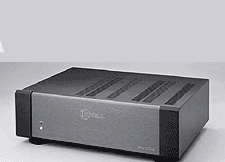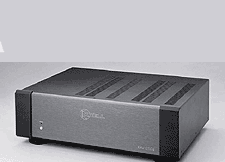


What signals are you receiving from Krell? What do you make of the turnaround that has produced so much prime entry-level gear?
Let's not be too glib about this, for even the Krell components we're about to explore sell for more than most people intend to spend during their entire lifetimes on hi-fi-related purchases. But the message, the writing on the wall, seems to be one of a new realisation from the major high end brands: Arab oil shieks, lottery winners, casino owners, rock stars and the like are the only people with enough money to support the ever-spiralling costs of high-end equipment...and they tend
• Read more audiophile stereo preamp reviews from brands like Audio Research, Classé, Mark Levinson, Krell, Linn, Naim and dozens others.
• Follow AudiophileReview.com for blog posts and opinion on the world of audiophile preamps including passive preamps, solid state preamps, tube preamps and more.
• Read Audiophile Power amp reviews here.
For years, the Wilson WATT/Puppy combo has been THE best selling high-end speaker in the world, and it sells for a heady £17,000. Add a suitable source and, for the sake of this review, Krell amplification, and you have a choice between that system and a Mercedes SLK, a derelict French farmhouse or 400 sessions with a Parisian streetwalker. Now wrap your mind around this: With Krell's previously released KAV-300cd CD player, the KAV-250 combo AND a pair of Wilson Cubs, you have a Krell/Wilson system for
By now, Krell watchers and wannabees know that the KAV-300i integrated amp is the most successful product the company has ever produced, and it's put Krell into a lot of homes which otherwise couldn't stretch to Krellness. Conversely, the high-end FPB amps are some of the best-received components the company has produced in years. What's left is a yawning gap between the £2550 integrated and the least expensive pre/power package, the KRC-3 (£3250) and the FPB-200 (£6490). The KAV-250p pre-amp and KAV-250a power amps fill that gap nicely at £1990 and £3290 respectively. And although they are, as the letters K-A-V tell us, part of the economical home theatre series and bear that particular look, they sound and feel properly Krellish.
If you're familiar with the KAV-300i, then you will find the KAV-250p immediately recognisable. It is, as sense would dictate, fundamentally a KAV-300i minus the power amplifier stages, but with a few added refinements. And as every integrated vs separates argument has always accepted, the latter usually win by virtue of the extra power supply occasioned by two separate chassis. While I no longer have a KAV300i to hand to try in pre-amp-only mode, I have been assured by a learned colleague that the KAV-250p is a better pre-amp than the pre-amp section of a KAV-300i used as a pre-amp. And this isn't surprising, if previous experience of other integrated amps split into their constituent parts is anything by which to predict a result. But what I do have to hand for comparison's sake is the KRC-3...
Like the integrated, the KAV-250p comes with a remote control, lacks a rotary volume control and uses up/down buttons and LEDs instead, it features three single-ended line inputs and one balanced, a tape loop and provision for both balanced and single-ended outputs. Other niceties include full synergy with RC-5 remote control systems for multi-room compatibility and home theatre products. It takes only a few moments to get used to a preamp devoid of knobs and bearing only push buttons, but I found myself using the remote control nearly all the time.
At 483x89x394mm (WHD), the KAV-250p could be mistaken for the '300i, and it stacks perfectly with the '300cd. What distinguishes it visually from the KRC-3 is the lack of a black strip in the middle of the fascia. Other aspects of the KRC-3 which go some way to qualify a higher price tag are polarity inversion lacking on the '250, a (digital) rotary volume control and seemingly more substantial build quality. That aside, the KAV-250p employs Krell's Current Mode Gain Class A, fully complementary circuitry, microprocessor control over level, balance and source switching, dry-contact relays for the input switching and a typically substantial toroidal power supply.
While the KAV-250p is, like the product sheet says, 'Obviously Krell', the KAV-250a is something of a dark horse. It's too petite, too understated, too compact to scream "Dan Made Me!!!" This does not look like the kind of amp which Arnie would fit in the back of his Hummer. It measures only 483x160x389mm (WHD) and weighs a mere 19.5kg. Gone are the handles of yore and the lightshow of the present; the front panel carries only an on/off button and an LED, the back a pair of multi-way binding posts and socketry for a choice of single-ended or balanced operation. The one frill, for those who wish to bi-amp or add remote zones, is line-level throughput to allow daisy chaining of amplifiers...just like Musical Fidelity's wee X-A50.
Naturally, there is a reduction in the level of sophistication which otherwise produces an FPB-series amplifier. There's not a word about Class-A operation other than to describe the input and driver circuitry, there's no suggestion of the same level of song'n'dance system-monitoring which baby-sits an FBP. Still, a basic description just doesn't do justice to this sleeper, this velociraptor in sheep's clothing. Despite looking like what would be a 100-watter from any other firm, it's a stereo amp bridgeable from 250W/ch to 1kW mono, both figures into 8 ohms.
As with every Krell amp ever made, the power supply is so far over the top as to call to mind cars with too much engine: think AC Cobra or, if you're a century older, Fiat Mephistopheles. A gigantic toroidal transformer, over 50,000 microfarads of filter capacitance, a 2kVA rating: this amp will have a rather intimate relationship with your AC supply. And, power supply aside, the rest of the amp is dual mono, the two sub-assemblies matched to ensure absolutely no variations from channel to channel. Again, the circuitry is fully complementary, wide-bandwidth and balanced from input to output. And, as you'd expect, it's quiet, stable and bomb-proof. But who could've imagined how
Its proprietary output transistors, made for Krell by Motorola, are unique, high-speed designs conceived to provide higher gain and greater output current, and it shows. The trend toward absurdly high-sensitivity figures for modern speakers regardless of price category or purpose, means scant use of the volume control but this does nothing to compromise the sense of unbridled, unlimited, omnipresent power. From the 94dB/1W/1m Wilson CUBs down to LS3/5As and Quad 77-10Ls, Apogee Ribbon Monitors and Genexxa LX Pro-5s to Quad ESLs and 63s, the KAV-250a always implied the availability of more grunt than you'd ever have to access. And in every case listed, merely turning up the wick for the sake of it would have involved either levels which would have antagonised the neighbours, or speakers damaged beyond repair.
Not that I needed the extra 6dB of level, I used the combination only in balanced mode, connected with Transparent Music Link, feeding the various speakers through Harmonix speaker wire. For sources, I used the YBA CD3, the Krell KAV-300cd (in balanced mode) and a smattering of Marantz players and Musical Fidelity accessories. The 'control' or 'reference' during the sessions was the KRC-3, which I've been using for some months, but auditioning side-by-side with the various power amps in my possession proved meaningless when it came to power, dynamics or slam. All they were good for was assessing tonal accuracy, three-dimensionality, transparency and other
It hasn't quite occurred to me how an amplifier like the KAV-250a manages to communicate a feeling of menace and force and authority even when the source material is, well, twee. How does a number like 'That's Amore' suddenly acquire the sheer mass of a Motorhead epic? What weird magic renders the a capella Persuasions as (sonically) palpable as Nirvana?
Read more on Page 2

A couple of recent remarks, inspired as much by the prevalence of high sensitivity speakers as the continued existence of high powered amps, will prove anathematical to the sleazy little shits who hide behind 92dB-plus speakers because their amps have no testicular worth whatsoever. Anthony Michaelson eloquently insists, despite his new Kelly speakers offering sensitivities to make a 300B user swoon, that his amplifiers deliver enough current to control the speaker, to avoid even the slightest vestiges of clipping and to compensate for the ludicrous industry standard of measuring sensitivity at 1m when no sane individual sits that close to a speaker. Take a minute to read his reply to a reader's letter on p7,
The other remark came from Dan D'Agostino himself when interviewed recently by Jeffrey Tan in Malaysia's
As in absolute power. But not necessarily corrupting absolutely. Quite apart from turning the user into an irresponsible, possibly dangerous threat - as too much power in a car might do - the knowledge that this amplifier pumps out enough juice to sizzle tweeters like mosquitoes in a bug-zapper forces one to use it judiciously. Or not, depending on your attitude toward maximum SPLs. What's certain, though, is that you're unlikely to reach its limits with many speakers to the right of an Apogee Scintilla. And still you'll be able to delight in subtlety and finesse, transparency enough to exhaust us of visual similes, (nearly) sufficient warmth to stifle tubular tendencies and a solidity to the sounds and images that precludes the use of the word 'holographic'. Because holograms ain't this good.
The KAV-250p, lest we forget it, is nearly as much of a bargain as its amplifying sibling, sounding as it does like a marginally less-precise KRC-3. But the price difference will make up most customers minds so readily that avoiding a frustrating demo of the latter isn't necessarily a problem. Although it lacks the absolute refinement and dynamic "legs" of the KRC-3, the KAV-250p is still very much a commanding, coherent performer, sweeter than you'd expect and unashamedly capable of driving the KAV-250a with plenty of panache. And should you wind up in the hands of a sadistic retailer who tries to sell you up to a KRC-3, you'll only regret not buying the dearer pre-amp for about, say, 15 seconds after you switch on the KAV-250p at home.
Quite clearly, Krell has moved the goal-posts again, having hit the 2000- 3000 sector last year like Conan the Destroyer with the KAV-300i integrated. Now there's a pre/power combo available for those who need more than 150W/ch. Only it's like moving from a Derringer to a Howitzer. You have been warned.
But don't let that stop you.